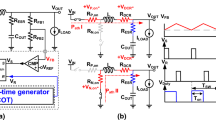Abstract
Digital linear slope control (LSC) method is proposed to reduce the output voltage deviation during the load transient of a buck converter. The proposed LSC method modulates the slope of the control signal to suppress the output voltage deviation. The LSC method utilizes the information of the output voltage only and is realized simply by adding a few lines to the digital code of the conventional VMC. The mathematical analysis is conducted to prove the feasibility of the LSC method and the algorithms for the LSC method are presented. A 15 V–5 V 100-kHz prototype buck converter was built and tested to verify the performance of the LSC method.










Similar content being viewed by others
Data availability
Data that support the findings of the study are available from the first and corresponding authors, upon reasonable request.
References
Chen, C.L., Lai, W.J., Liu, T.H., Chen, K.H.: Zero current detection technique for fast transient response in buck DC–DC converters, 2008 IEEE International Symposium on Circuits and Systems (ISCAS), pp. 2214–2217 (2008)
Malcovati, P., Belloni, M., Gozzini, F., Bazzani, C., Baschirotto, A.: A 0.18-µm CMOS, 91%-efficiency, 2-A scalable buck-boost DC–DC converter for LED drivers. IEEE Trans. Power Electron. 29(10), 5392–5398 (2014)
Khan, N., Piqué, G.V., Pigott, J., Bergveld, H.J., Sherif, A.E., Trescases, O.: An auxiliary-assisted dual-inductor hybrid DC–DC converter with adaptive inductor slew rate for fast transient response in 48-V automotive PoL applications, 2022 IEEE 23rd Workshop on Control and Modeling for Power Electronics (COMPEL), pp. 1–6 (2022)
Sable, D.M., Ridley, R.B.: Comparison of performance of single-loop and current-injection control for PWM converters that operate in both continuous and discontinuous modes of operation. IEEE Trans. Power Electron. 7(1), 136–142 (1992)
Choi, B.: Step load response of a current-mode-controlled DC-to-DC converter. IEEE Trans. Aerosp. Electron. Syst. 33(4), 1115–1121 (1997)
D. Goder, D., Pelletier, W.R.: V2 architecture provides ultra-fast transient response in switch power supplies. In: Proc. HFPC Conf., pp. 19–23 (1996)
Zhou, G., Xu, J., Wang, J.: Constant-frequency peak-ripple-based control of buck converter in CCM: review, unification, and duality. IEEE Trans. Industr. Electron. 61(3), 1280–1291 (2014)
Tian, S., Lee, F.C., Li, Q., Yan, Y.: Unified equivalent circuit model and optimal design of V2 controlled buck converters. IEEE Trans. Power Electron. 31(2), 1734–1744 (2016)
Duan, X., Huang, A.Q.: Current-mode variable-frequency control architecture for high-current low-voltage DC–DC converters. IEEE Trans. Power Electron. 21(4), 1133–1137 (2006)
Yan, Y., Lee, F.C., Mattavelli, P.: Comparison of small signal characteristics in current mode control schemes for point-of-load buck converter applications. IEEE Trans. Power Electron. 28(7), 3405–3414 (2013)
Bari, S., Li, Q., Lee, F.C.: A new fast adaptive on-time control for transient response improvement in constant on-time control. IEEE Trans. Power Electron. 33(3), 2680–2689 (2018)
Meyer, E., Zhang, Z., Liu, Y.F.: An optimal control method for buck converters using a practical capacitor charge balance technique. IEEE IEEE Transactions on Power Electronics 23(4), 1802–1812 (2008)
Kapat, S., Krein, P.: Improved time optimal control of a buck converter based on capacitor current. IEEE Trans. Power Electron. 27(3), 1444–1454 (2012)
Feng, G., Meyer, E., Liu, Y.F.: A new digital control algorithm to achieve optimal dynamic performance in DC-to-DC converters. IEEE Trans. Power Electron. 22(4), 1489–1498 (2007)
Corradini, L., Costabeber, A., Mattavelli, P., Saggini, S.: Parameter-independent time-optimal digital control for point-of-load converters. IEEE Trans. Power Electron. 24(10), 2235–2248 (2009)
Corradini, L., Babazadeh, A., Bjeleti, A., Maksimovic, D.: Current-limited time-optimal response in digitally controlled DC–DC converters. IEEE Trans. Power Electron. 25(11), 2869–2880 (2010)
Meyer, E., Zhang, Z., Liu, Y.F.: Digital charge balance controller to improve the loading/unloading transient response of buck converters. IEEE Trans. Power Electron. 27(3), 1314–1326 (2012)
Kim, D., Baek, J., Lee, J., Shin, J., Shin, J.-W.: Implementation of soft-switching auxiliary current control for faster load transient response. IEEE Access 9, 7092–7106 (2021)
Kim, D., Hong, M., Baek, J., Lee, J., Shin, H., Shin, J.-W.: Soft-switching auxiliary current control for improving load transient response of buck converter. IEEE Trans. Power Electron. 36(3), 2488–2494 (2021)
Kim, D., Shin, J.-W.: Dynamic response of buck converter with auxiliary current control: analysis and design of practical implementation. IEEE Trans. Power Electron. 36(12), 13917–13929 (2021)
Acknowledgements
This research was supported by the National Research Foundation of Korea (NRF) funded by the Ministry of Science and ICT under Grants 2021M1A2A2060313 and 2022R1C1C1010027, and Chung-Ang University Graduate Research Scholarship in 2021.
Author information
Authors and Affiliations
Corresponding author
Rights and permissions
Springer Nature or its licensor (e.g. a society or other partner) holds exclusive rights to this article under a publishing agreement with the author(s) or other rightsholder(s); author self-archiving of the accepted manuscript version of this article is solely governed by the terms of such publishing agreement and applicable law.
About this article
Cite this article
Kim, S., Baek, J., Shin, J. et al. Digital linear slope control method for improving the load transient response of a buck converter. J. Power Electron. 23, 400–409 (2023). https://doi.org/10.1007/s43236-023-00593-4
Received:
Revised:
Accepted:
Published:
Issue Date:
DOI: https://doi.org/10.1007/s43236-023-00593-4




